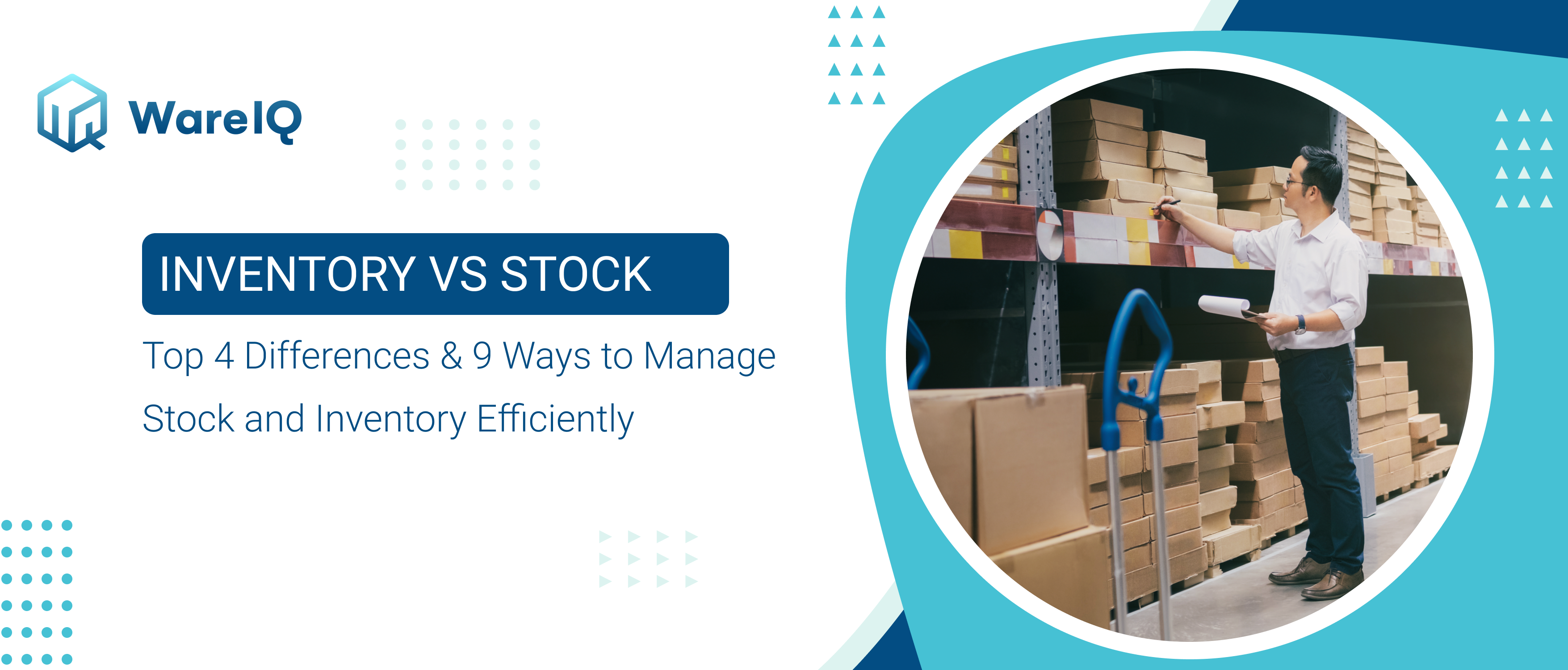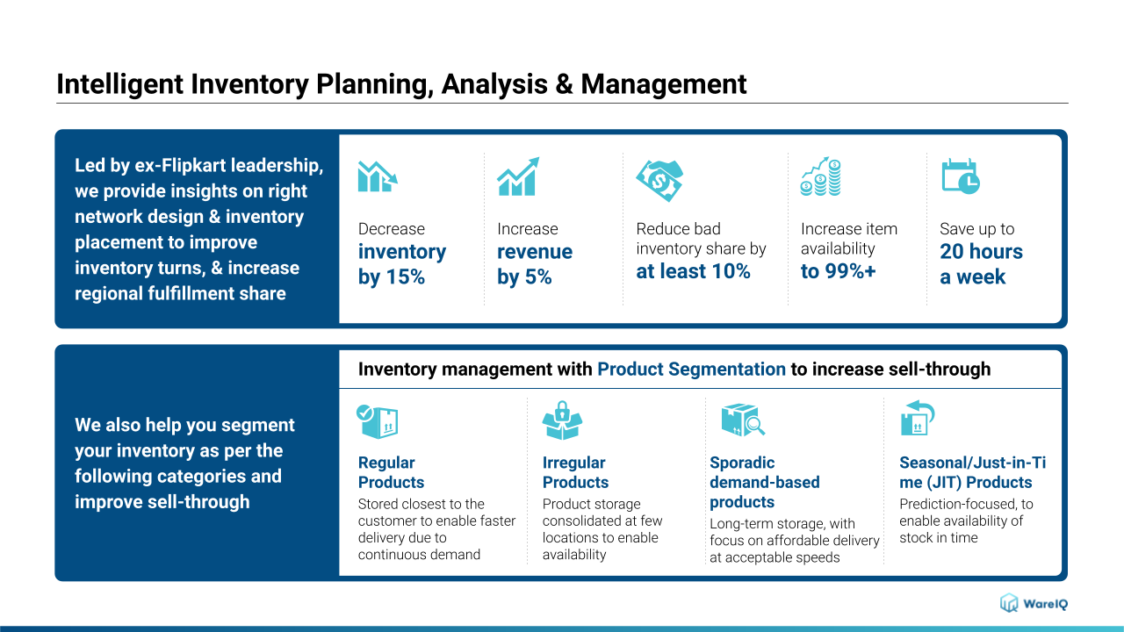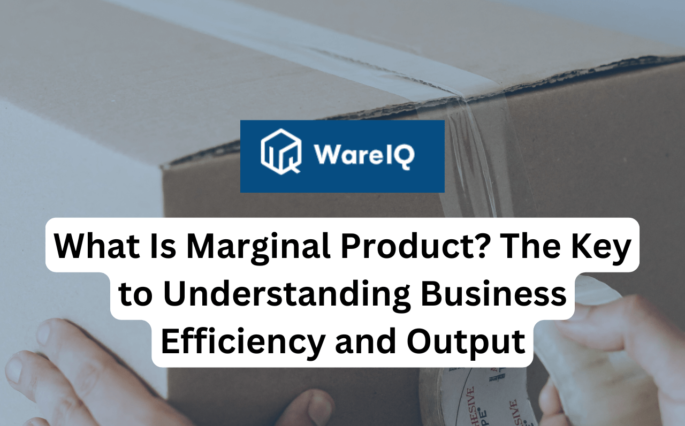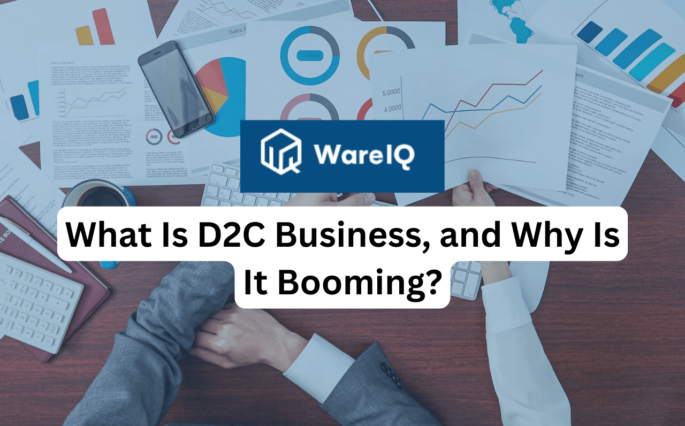Inventory Vs Stock: Top 4 Differences, Definitions and 9 Ways to Manage Them Efficiently in 2025

Both inventory and stock are key components of any eCommerce company. They are directly responsible for a business being able to sell products in the first place. If companies don’t maintain an optimum level of inventory and stock, their ability to receive orders and fulfil them often falls by the wayside. In this article, we will take a look at the differences between inventory vs stock, examples of inventory vs stock, definitions and a lot more.
- What is the Meaning of Stock?
- What is the Meaning of Inventory?
- Inventory Vs Stock: Examples
- Inventory vs Stock: 9 Efficient Ways to Manage Stock Inventory
- Key Difference Between Inventory and Stock
- Inventory Vs Stock: Comparative Table
- Conclusion: How Does WareIQ Sets Itself Apart From Other Logistics Companies in Inventory vs Stock Management?
- Inventory vs Stock FAQS
What is the Meaning of Stock?
The number of finished goods available to be supplied to the end customer is referred to as stock. If the store sells items directly to customers to make a profit, it can also include raw ingredients.
Examples of Stock: Packs of pens in storage for pen manufacturers.
WareIQ, an eCommerce fulfillment company, empowers online brands with a superior-tech platform to compete with Amazon like service levels by bringing their average delivery timelines from 5-10 days to 1-2 days.
What is the Meaning of Inventory?
Finished items, raw materials and work-in-progress products can be included in inventory. Inventory must be kept at an optimal level since it is linked to carrying expenses so that all sold and unsold products can be accounted for throughout the financial year.
Examples of inventory: lids of pens, ink, refills etc.
Inventory Vs Stock: Examples
Examples of Stock
Pen companies use the term “stock” to refer to finished versions that are kept and ready to be fulfilled since they sell a wide range of pens to the end customer. Every completed pen has an SKU number and a barcode that can be scanned to identify and locate finished products, allowing them to be fulfilled swiftly.
If a pen company supplies other firms with pen casings/nibs, they will be classified as finished items and computed as stock.
Examples of Inventory
Plastic, ink, metal, paper, packing boxes and other raw materials that are utilised to make pens are examples of inventory. A few other examples are:
- Individual lids and containers before they are brought together in the pen.
- Products that have passed all quality inspections and have finished all stages of the manufacturing process.
- Materials such as casings, lid pipes, nib metals and screws are necessary for the maintenance, repair and operation of machinery used in manufacturing pens.
Inventory vs Stock: 9 Efficient Ways to Manage Stock Inventory
Prioritise
The first and foremost way of efficiently managing your inventory is the organisation into categories, based on priority. This will help you in determining the frequency and quantity of the inventory, as well as knowing what you need regularly. It will also help you in identifying the commodities that are vital to your business though they may cost more and take longer to sell.
An easy way is to divide the items of inventory into three basic categories, X, Y and Z. The more expensive items that are required in lesser quantities are put into category X and items that cost less but are required in larger quantities are put in category Z. The middle category Y consists of items that are reasonably priced and have a turnover rate higher than category X and lower than Y.
Track
The next step would be proper maintenance of the records that contain product specifications and other information about every item included in the inventory. These records should include essential data such as SKUs, barcode data, suppliers, country of origin and lot numbers. The price of these items should also be tracked from time to time so that you would know their availability and seasonal fluctuations which may lead to changes in the price.
Examine
Some firms conduct a comprehensive inventory count once a year. Other firms conduct random product checks on a monthly, weekly or even daily basis. Either way, it is a good practice to count your inventory frequently.
Analyse
At times, you may have to deal with an untrustworthy supplier who may jeopardize your inventory. It is important to analyze and take action if your supplier consistently fails to produce orders or has quality control issues. Address the issues with your provider to determine what is going on. Prepare to change business partners or deal with unexpected supply levels and the potential risk of running out of supplies.
80/20 rule
In general, revenues from 20% of resources lead to benefits for 80% of the workforce. It is important to make inventory management for 20% of products a top priority. You should possess knowledge as to the time period for how long they last on the market as well as the number of items sold during that time. This is essential so that you don’t throw away the goods that will make you the most money.
Consistency
The approach to inventory and stock management should be consistent. A hazy or shifting attitude will result in a mismatch between purchased orders and sales plus inventory. To maintain an efficient and successful system, a clear and straightforward inventory and stock management system should be implemented and followed by everyone in the organization.
Sales
In a discussion about inventory vs stock management, sales cannot be ignored. In the interest of being accurate, sales, inventory and stocks should all match up comprehensively. In addition to matching inventory and stock, sales numbers aid in assessing the items that are selling quickly and how certain events drive or lower sales. It is necessary to constantly analyze sales volumes to correctly manage inventory and supplies. Sales numbers also aid in estimating the inventory-to-stock ratio.
Restocking
Some suppliers offer inventory reordering services. At first glance, this appears to be a good thing: delegating the method for at least a few of your items saves you money and time. However, keep in mind that your providers may not share your objectives. They want to move their inventory, while you want to stock the best products for your business. Take the time to review your inventory and rearrange all of your items.
Software
In a smaller organization, you may maintain the first few items of the inventory list manually with spreadsheets and diaries. However, if your company expands, you will need to dedicate more time to managing stock than to your business or you will risk having too much or too little stock. These responsibilities are simplified by investing in good inventory management software. Before choosing a technical platform, consider what you’re looking for, if it has the information you need and whether it is user-friendly or not. At the same time, you should select a solution that can be integrated into your existing systems.
Key Difference Between Inventory and Stock
When it comes to stock inventory, people do not find it easy to distinguish between the two. Inventory generally consists of three components: The finished product, work in progress and raw materials.
For a Washing Machine manufacturer like IFB, the inventory will consist of:
- All the finished products, i.e., the washing machines ready to supply to the customer, whether at the retail site or warehouse.
- Inventory for IFB will also include all the washing machines that are under the process of manufacturing and are at different stages of completion.
- Finally, IFB inventory will also be inclusive of all the raw materials that the company has at its disposal for the purpose of manufacturing the same washing machines.
This simply entails inventory consisting of all the items included in the manufacturing cycle of IFB, from the acquisition of raw material to the machines in the various stages of production and, finally, the end product.
Now let us consider what the stock will be for the same manufacturer, IFB:
- IFB stock refers to the washing machines ready for delivery to the end-user.
- IF IFB supplies casing, motors or circuits to some other manufacturer, that will also be regarded as stock.
- We can simply say that any product that IFB sells to consumers or another manufacturer will be considered the stock of the company.
Inventory Vs Stock: Comparative Table
The differences between inventory and stock are listed below:
| Particulars | Stock | Inventory |
|---|---|---|
| Inclusions | All products that the company sells to end-users or another manufacturer in known as stock. | All finished products, work-in-progress goods and raw materials is known as inventory. |
| Applicability | It is used in day-to-day business operations as products bought by customers. | It’s primary usage is for accounting purposes and also for manufacturing items. |
| Calculations | Stock always commands the market price (selling price). | FIFO/LIFO analysis should be done to understand the actual cost to the company. |
| Frequency of Calculations | Calculations are done from time to time (daily/weekly/monthly) depending on the type of business. | It is generally done for accounting purposes at the time of preparation of financial books. |
Conclusion: How Does WareIQ Sets Itself Apart From Other Logistics Companies in Inventory vs Stock Management?
Inventory management systems may seem like an unnecessary complication when you start your business, but as you expand and the list of products you deal in increases, it becomes highly complicated to keep tabs on stock inventory.
To manage the stock inventory efficiently, there is a need for a technologically efficient system that works based on artificial intelligence and machine learning.
This will ensure that the management can glance through the inventory management system and arrive at various decisions regarding any product and this is where WareIQ stands different from other Logistics Companies.

WareIQ provides all these facilities that are aided with visuals and graphical representations. WareIQ clearly sets itself apart on the basis of:
- A single system that is capable of maintaining inventory, order and billing data.
- WareIQ also enables storage facilities in fulfilment centers of their own for an efficient supply cycle as required.
- Another amazing feature of WareIQ is the ease with which it gets set up and integrates with your system.
- The system is adaptable to various market fluctuations as well.
- Pan India Fulfillment & Darkstore Network: Plug-and-play fulfillment infrastructure with no minimums, which is compliant with Amazon Seller Flex, Flipkart Assured, Myntra and other marketplaces
- Inventory & Network Planning Excellence: Best-in-class AI models for sales forecasting, product segmentation, and inventory management to reduce inventory by 40% and increase revenue by 10%.
- Vertically Integrated Fulfillment Tech Stack: Our Fulfillment Tech Solution supports integrations with 20+ top marketplaces & D2C platforms, and prominent national, regional and hyperlocal couriers, enhancing reach by covering deliveries for 27,000+ pin codes
- Supply Chain Productivity Applications: Integrate a host of supply chain productivity apps with a single-click to your existing CRMs, ERPs & accounting software to manage your logistics workflows from one command center. Use Apps like RTO Shield to get 100% RTO protection, Branded Tracking to turn your order tracking page into a profitable marketing channel, and many more.
Trusted by 300+ top Indian brands, we are helping them accelerate online sales and expedite their growth through a synergistic combination of advanced technology, robust fulfillment infrastructure & seller enablement services!WareIQ is backed by leading global investors including Y Combinator, Funders Club, Flexport, Pioneer Fund, Soma Capital, and Emles Venture Partner.







